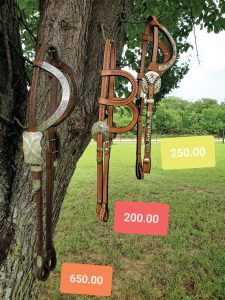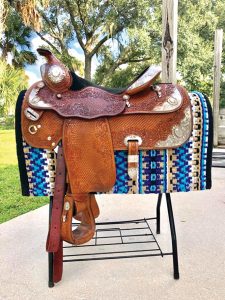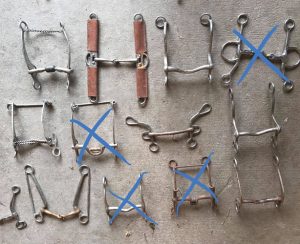A Facebook Guide to Selling Horse-Related Items
Click here to read the complete article
194 – August/September 2019
By Laura Boynton
 Attention spans are short and thumbs scroll fast on all social media platforms. Most people on Facebook and Instagram aren’t on these social media pages to find things to buy. However, just because they aren’t there to purchase your horse-related items doesn’t mean they can’t be enticed to do so…
Attention spans are short and thumbs scroll fast on all social media platforms. Most people on Facebook and Instagram aren’t on these social media pages to find things to buy. However, just because they aren’t there to purchase your horse-related items doesn’t mean they can’t be enticed to do so…
Facebook’s Multiple Storefronts
For a simple sale, you can use your own personal page to list an item. Only your friends will see your sale post, so it may take longer to sell, and you won’t get any widespread coverage. If you have only a couple of items to sell, this may be a good venue. Also, it may keep your sale local, so there’s no shipping and handling, and you can ask for cash in hand.
For special collections and high-ticket items, you can join sale groups to post your items. These groups are themed for certain items, companies, brands, sizes, location, and budget. All you need to do to find a group page is type a few descriptive phrases in the search bar. For example, after typing in phrases like “Harris halter” or “Showmanship outfit,” a few group sales pages will pop up. Just click on the page that suits your item and ask to join to become a member. Once approved, you may post photos and a description of the item you want to sell. One helpful tip is to remember to check all of your direct message requests, since you may be getting messages from people who aren’t your friends on Facebook.
You may also add your group sale posts to Facebook Market Place, which is like posting your item in a classified and category type venue that will draw many shoppers from within your area. To search on Market Place, just type in what you’re looking for, like “chaps” or “horse bits,” in the same search bar you use to type in the names of people. A full Facebook classified section will pop up, and scrolling through specific items being offered for sale has never been easier.
If you have a full tack room, and you constantly sell items, you might want to look into creating your own  Facebook Store.
Facebook Store.
You can use Facebook’s platform to set up an online store with a shopping cart checkout for easy payments. For that matter, you may also set up a store by using an e-commerce website builder. Shopify is the highest rated e-commerce website, and BigCommerce and Squarespace are just as easy to use. They sometimes run specials or offer a trial period, but these website builders cost anywhere from $9.99 and up monthly. Your sale links will automatically post in your store. This feature requires very little technological know-how, and it provides the opportunity to create a shopping experience on your timeline in order to reach a wider customer base. These apps appear on your timeline as a tab, and your customers can click on each tab to view your merchandise. Your store can have as many items as you like. You only have to update your sale posts once, and your inventory is tracked so it won’t show items that have already been sold. To create your Facebook Store, look for the Add Shop Section link below your cover photo. Agree to the Merchant Terms and Policies and enter your details. Then, the Call-to-Action button will change to a Shop Now button. To add Shopify, you just need to add Shopify’s free Channel app to your store.
Follow the Rules
Now, you have a place to sell, whether it’s on your page, in a group, or in your store. Make sure you follow the rules of the road, or else Facebook may deny you from posting or selling anything for a certain amount of time, or they will permanently ban you if you keep breaking their policies. You can appeal the suspension if Facebook has rejected your sale post for a specific reason.
Here are some Facebook and Instagram guidelines to remember:
• You can’t sell anything that isn’t a physical product. Selling healthcare or medical products isn’t allowed.
• Items that show a before and after picture aren’t allowed. For example, a weight loss product showing a before and after result are against two of Facebook’s policies.
• Selling animals isn’t allowed on Facebook Market Place or buy and sell group pages. This includes posting about animals for adoption. However, keep in mind that it’s okay to create a news feed post, or an ad about selling an animal or service on your own timeline.
• Facebook Commerce policies have long prohibited animal sales, but now Facebook has an added option that allows people to report animal sales. Even though we have all seen animals for sale on Facebook, some ads are cleverly written to disguise the fact that people are trying to sell an animal. Failure to comply may result in a variety of consequences, in- cluding your sale post being re- moved. A ban may be placed on your account as well.
• Sale post descriptions that don’t match the photos are prohibited. If your ad states certain details that are different in the photo, your sales ad will be removed.
Sell! Sell! Sell!
 After reading up on the rules, you will have a better idea about what Facebook accepts to be proper and legitimate, from a sales standpoint. If you decide to have a Facebook store, the first thing you need to do after posting your sale ads is to grow a fan base. Growing a fan base is very important as it will create likes and help spread the word on what you have to offer. You can offer specials like coupons, flash sales, BOGO’s, free shipping for first time customers, and contests to encourage shoppers to view your sale page . Incentives should be tailored to fellow horse lovers. There’s no harm in gaining customer’s email addresses to share your other horse-related information and services, horses for sale, and to send them special offers outside of Facebook.
After reading up on the rules, you will have a better idea about what Facebook accepts to be proper and legitimate, from a sales standpoint. If you decide to have a Facebook store, the first thing you need to do after posting your sale ads is to grow a fan base. Growing a fan base is very important as it will create likes and help spread the word on what you have to offer. You can offer specials like coupons, flash sales, BOGO’s, free shipping for first time customers, and contests to encourage shoppers to view your sale page . Incentives should be tailored to fellow horse lovers. There’s no harm in gaining customer’s email addresses to share your other horse-related information and services, horses for sale, and to send them special offers outside of Facebook.
It’s extremely beneficial to allow people to leave reviews on your sale page wall. Encourage customers to share their shopping experiences with you. If the experience is a good one, thank them. If there is an issue, address the problem on your wall, and offer a solution. By providing full disclosure, you will be showing your current and potential customers that you’re committed to their satisfaction. A first-time visitor to your store, who sees you properly addressing a complaint, will feel much better about doing business with you.
Do’s and Don’ts of Posting ‘For Sale’ Items
• Do use catchy headlines and eye-catching titles along with attention-getting photos.
• Don’t post photos of dirty or messy items. Don’t post photos that have clutter surrounding your sale item. Unclean items and backgrounds can discourage a buyer from looking. Using poor quality photos of your items won’t get the job done either. There’s nothing like a clear, high definition image to show off the item you want to sell.
• DO take photos in outdoor, natural lighting or inside with a flash. Take the time to clean, wash, iron, and display your items in the most eye-catching way. Use a dress form, hooks, or hang up clothing items neatly to show the overall look.
• DO be honest in your sale descriptions. Never exaggerate the condition of something you’re selling. You will lose creditability if you aren’t truthful.
• Don’t hide any damage. It’s best to mention any rips, stains, dents, scratches, holes, broken pieces, etc. in your ad and to have the pictures that show the extent of the damage. Showing the faults on an item is better than having a surprised buyer when they unwrap their purchase and find a problem.
• DO offer serial numbers for saddles that show the company, maker, and name of the product. Also, take photos that show the dimension and measurements by using a tape measure in the image. Also, take a photo of the tags that have the size and brand name on all horse and rider attire. This will grab the attention of the shopper who won’t read all the words of a sale post.
• DO check the company’s websites for help with pricing. You’ll never sell your stuff if it’s priced too high. Most items aren’t worth what you originally paid for them, new or used.
• Don’t be easily offended by low-ball offers and tire kickers. It’s all part of this game. Know your lowest price and don’t settle until you’re ready to adjust your price. You also have to realize that you have a better chance of selling if you’re flexible.
• DO answer customer’s questions in a quick and timely man- ner. Social media shoppers will move on to the next sale ad if kept waiting too long.
• DO have a return policy, payment options, and shipping information posted. If you don’t want to accept returns, only want to use PayPal, and ship once a week on Friday, then be very clear with your customers about your policies.
• Don’t sell unsafe, counterfeit, or recalled products. It’s not worth the trouble you could get into.
It’s All in the Shipping
1. Ship items in correct fitting, sturdy, cardboard boxes or padded shipping envelopes with adequate bubble wrap and padding for protection.
and padding for protection.
2. Using the USPS–the United States Postal Service–is the cheapest way to ship items. The USPS has options with one-day, two-day, and three- to five-day shipping options that will most likely get your buyer the goods within a reasonable time frame. Fed-Ex and UPS are significantly more expensive. You can offer a faster shipping service if the buyer would like to cover that extra cost. Sometimes, people are in a rush to receive an item, and it’s fair for you to ask them to pay for the expedited shipping option.
3. It’s standard practice for the buyer to pay for shipping. It isn’t up to the seller to pay for shipping when they could sell it locally for a lot less cost and stress. The seller usually covers the basic insurance cost to protect the item for non-delivery or damage in shipping. This protects their investment until the package reaches the buyer. All shipping options offer insurance up to a certain amount, usually $50 dollars. If the item you’re sending costs over that, then it’s well worth the extra cost to get insurance to match the purchase price.
Show Me the Money
There’s a breakdown of the most popular third-party payment services that buyers and sellers use on Facebook.
PayPal is the industry standard for accepting digital payments from customers through your email. The checkout button PayPal provides to your store will help you manage your payments because you can create and send invoices. PayPal charges 2.9% plus .30 cents per transaction, and rates go down with higher sale totals. PayPal also has a Friends and Family invoice. There is no fee for the buyer if you select this way to pay. You should only agree to Friends and Family when you trust the seller/buyer, because there is limited protection. Big and small companies even use this uncomplicated program. PayPal will assist the buyer and seller 24/7 with any concerns and has tech support.
Square offers free online store sites where you can list all your items and services. With Square, you will have more options to market your items on a variety of sites to expand sales. The charge is 2.75% fee on every transaction made online. This payment program is effortless like PayPal and has 24/7 tech support, also.
Stripe has a new way of checking out so your customer stays on your website and isn’t redirected to another sales site. Stripe works on multiple electronic devices with no extra work or programs needed. They charge 2.9% plus a .30-cent charge on every transaction. Stripe can be more involved, but it spreads your sale ads to many more shoppers. Like the others, this company has tech support 24 hours a day.
Sending payment through Venmo comes with a 3% fee, but this company waives that expense when the transaction is paid for with a Venmo bank account or debt card. This fee is not waived when using other credit or debit cards. This service comes with texts between users, shows when payment is received by the seller, and shows the deduction from the buyer’s Venmo account. Signing up for a Venmo account is fast and accessible online and by phone. Venmo provides the same safety measures as the major credit card companies with 24-hour tech support.
Dealing With Problems
 Most payment issues and grievances can be worked out through the seller’s and buyer’s payment service. If the buyer used a credit card to purchase an item, many cards offer additional coverage and reimbursement if an issue arises. Often, payment balances are immediately deducted from the buyer’s account and transferred into the seller’s account. Usually, the item can ship out the next business day. Most of the sellers will not ship items until full payment is made. To protect the value of the item, the seller shouldn’t risk shipping without payment from the buyer or putting insurance on the package during shipping.
Most payment issues and grievances can be worked out through the seller’s and buyer’s payment service. If the buyer used a credit card to purchase an item, many cards offer additional coverage and reimbursement if an issue arises. Often, payment balances are immediately deducted from the buyer’s account and transferred into the seller’s account. Usually, the item can ship out the next business day. Most of the sellers will not ship items until full payment is made. To protect the value of the item, the seller shouldn’t risk shipping without payment from the buyer or putting insurance on the package during shipping.
The best way to get paid–and the least stressful and technical way–is the local, cash-in-hand sale. However, the seller may spend more money on gas driving to meet the buyer than the items are worth. Not to mention, it’s very time-consuming to make a drop-off appointment and to deal with buyer’s remorse, a no-show, or someone who’s running late. Stay safe by meeting the buyer in a public place with a friend in tow. Think twice about accepting checks from people you don’t know, due to counterfeit cashier’s checks, stolen checks, and checks written from closed bank accounts. Make it known to the buyer that you only take cash in order to avoid any issues.
Social media selling is quite effective; but, make no mistake, generating sales is still a tough job. There is one major warning you must know before you set out to sell anything horse-related on Facebook. Be prepared to be tempted to spend all your profits on more horse-related items. The more you’re on sale pages, membership group sale pages, and in the Facebook Market Place, the more you will be tempted into buying another equestrian’s stuff! It’s a vicious cycle, my friends.
Click here to read the complete article194 – August/September 2019










